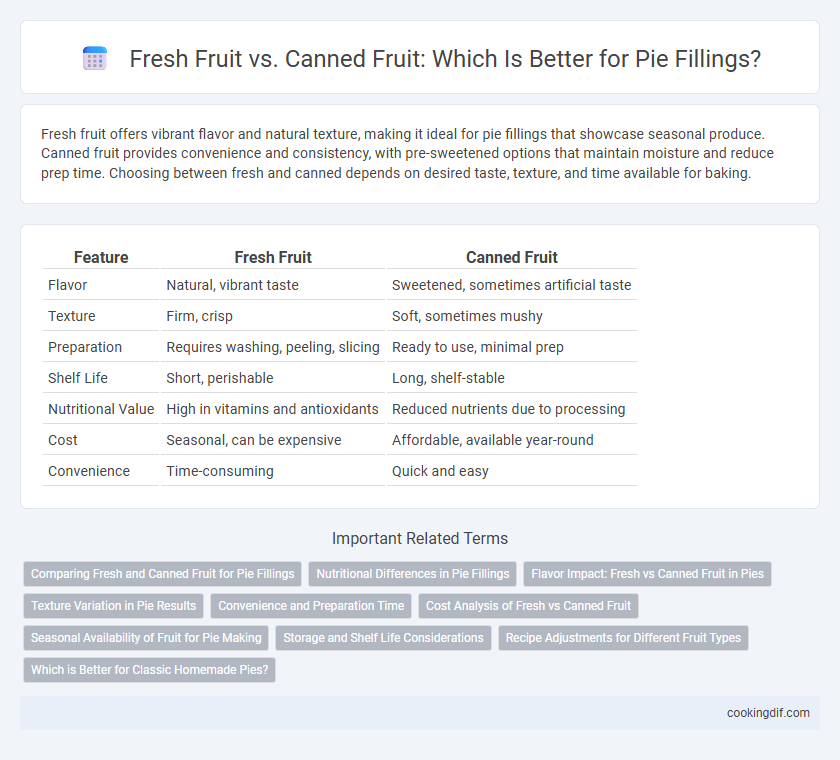Fresh fruit offers vibrant flavor and natural texture, making it ideal for pie fillings that showcase seasonal produce. Canned fruit provides convenience and consistency, with pre-sweetened options that maintain moisture and reduce prep time. Choosing between fresh and canned depends on desired taste, texture, and time available for baking.
Table of Comparison
| Feature | Fresh Fruit | Canned Fruit |
|---|---|---|
| Flavor | Natural, vibrant taste | Sweetened, sometimes artificial taste |
| Texture | Firm, crisp | Soft, sometimes mushy |
| Preparation | Requires washing, peeling, slicing | Ready to use, minimal prep |
| Shelf Life | Short, perishable | Long, shelf-stable |
| Nutritional Value | High in vitamins and antioxidants | Reduced nutrients due to processing |
| Cost | Seasonal, can be expensive | Affordable, available year-round |
| Convenience | Time-consuming | Quick and easy |
Comparing Fresh and Canned Fruit for Pie Fillings
Fresh fruit pie fillings offer vibrant flavors and natural textures that enhance the overall taste and mouthfeel of pies, while canned fruit provides convenience and consistent availability year-round. Fresh fruits contain higher levels of natural sugars and antioxidants, contributing to richer taste profiles, whereas canned fruits often include added sugars and preservatives that can affect flavor and moisture levels. Choosing between fresh and canned fruit depends on the desired pie texture, sweetness, and preparation time, with fresh fruit preferred for artisanal pies and canned fruit ideal for quick, reliable baking.
Nutritional Differences in Pie Fillings
Fresh fruit pie fillings retain higher levels of vitamins C and A, contributing essential antioxidants and fiber to the diet. Canned fruit fillings often contain added sugars and preservatives, which can reduce nutrient density and increase caloric content. Choosing fresh fruit ensures maximum nutrient retention and a more natural flavor profile in pie fillings.
Flavor Impact: Fresh vs Canned Fruit in Pies
Fresh fruit pie fillings offer a vibrant, natural flavor with a crisp texture that enhances the overall taste experience, while canned fruit tends to have a softer consistency and a sweeter, sometimes syrupy taste due to added sugars and preservatives. The flavor impact of fresh fruit is more pronounced and nuanced, providing brightness and freshness that elevates traditional pie recipes. In contrast, canned fruit's uniform sweetness and reduced acidity can mellow the pie's flavor, making fresh options preferable for a more authentic and flavorful pie.
Texture Variation in Pie Results
Fresh fruit pie fillings provide a natural texture with distinct layers of soft and slightly firm fruit, resulting in a more vibrant and varied mouthfeel. Canned fruit fillings often yield a uniform, softer texture due to the preservation process and syrup, which can cause a smoother but less complex bite. Texture variation significantly impacts the sensory experience, with fresh fruit pies offering a more dynamic and appealing contrast compared to the consistently tender texture of canned fruit pies.
Convenience and Preparation Time
Fresh fruit pie fillings offer a natural flavor and texture but require peeling, slicing, and sometimes macerating, which can be time-consuming. Canned fruit fillings provide a convenient, ready-to-use option with pre-sweetened and softened fruit, significantly reducing preparation time. Choosing canned fruit can streamline the baking process, especially for quick or last-minute pie-making projects.
Cost Analysis of Fresh vs Canned Fruit
Fresh fruit for pie fillings often incurs higher upfront costs due to seasonal availability and perishability, while canned fruit offers a more economical option with extended shelf life and reduced waste. The price per pound of canned fruit is generally lower and remains stable year-round, making it budget-friendly for large-batch baking. Cost analysis reveals that using canned fruit minimizes overhead expenses linked to storage and spoilage, providing a consistent and affordable filling for pies.
Seasonal Availability of Fruit for Pie Making
Fresh fruit for pie fillings offers vibrant flavor and texture, especially when using seasonal varieties like cherries in summer or apples in fall, ensuring peak ripeness and natural sweetness. Canned fruit provides year-round availability and convenience but may include added sugars and altered textures that affect the pie's quality. Choosing fresh, seasonal fruit enhances the authenticity and taste of pies, aligning with natural harvest cycles for optimal flavor.
Storage and Shelf Life Considerations
Fresh fruit pie fillings offer superior flavor and texture but require refrigeration and typically last only 3 to 5 days before spoiling. Canned fruit fillings provide convenience with a significantly longer shelf life, often up to 12 to 18 months when stored in a cool, dry place, making them ideal for long-term use. Proper storage conditions and attention to expiration dates are essential to maintain quality and prevent spoilage in both fresh and canned fruit pie fillings.
Recipe Adjustments for Different Fruit Types
Fresh fruit pie fillings require adjustments in sugar and thickener amounts due to higher moisture content and natural flavors. Canned fruit often contains added syrup, necessitating reduced sugar in the recipe and careful evaluation of thickening agents like cornstarch or tapioca. Balancing these factors ensures optimal texture and flavor in pies made with either fresh or canned fruit.
Which is Better for Classic Homemade Pies?
Fresh fruit offers superior flavor, texture, and nutritional value for classic homemade pie fillings, delivering a natural sweetness and vibrant aroma that canned fruit often lacks. While canned fruit provides convenience and year-round availability, it usually contains added sugars and preservatives that can alter the pie's consistency and taste. For traditional pies like apple, cherry, or blueberry, fresh fruit is generally preferred to achieve an authentic, homemade quality.
Fresh fruit vs canned fruit for pie fillings Infographic

 cookingdif.com
cookingdif.com